


Uranus is the "tipped over" planet! As if "lying on its side," it seems to "roll along" in its orbit! (1.6.x) (1.4.1)
Uranus, the seventh planet from the Sun, points one of its poles toward the Sun about every 42 years! (1.6.x) (1.4.1)
Uranus has a dim but complex ring system, and it is attended by an impressive retinue of small moons! (1.6.x)
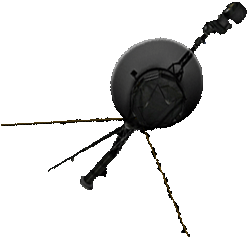
CLOUDTOP VIEW
A gas giant, Uranus has no solid or liquid "surface". So its "visible surface" is really the top of its complex cloud system! As no spacecraft has yet sent back pictures from within or directly above the planet's awesome cloud layers, artists' depictions will have to suffice for now.
SkyMarvels™ Illustration: Above Uranus's Clouds.
NASA Illustration: Cloudtops of Uranus.
The five major moons of Uranus orbit in nearly circular orbits. Four orbit the "tipped over planet" very close to its equato- rial plane, but Miranda's orbit is tilted about 4⅓°.
Uranus orbits on its side, so the cross section of
its major moons' orbits is shown vertically below.
Miranda, Ariel, Titania
and Oberon are named
for characters in Shakespearean plays. Umbriel is named for
a character in an Alexander Pope poem.
CELES-TIPS
The following will help you enjoy this page's 1.6.x and 1.4.1 links that run events directly in CELESTIA. If you're new to the program, these tips will also help you learn to use it.
Are you unfamiliar with our 1.6.x and 1.4.1 links? For an explanation click here.
You'll find more information about many of CELESTIA's controls on our Learning Center page.
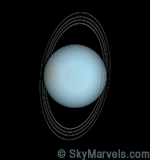
URANUS:
the "Tipped-Over"
Planet
Orbiting on its side,
every 42 years it
points one of its
poles toward us
here on Earth!
URANUS
View Uranus in 3-D in Orbit
Current Views and Conditions from Earth Major Moons
Current Location in the Constel. Skypath 2024
Current Location in Orbit
Physical Properties:
Equatorial Size: Compare in 3-D
Radius: 25,559 km
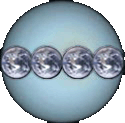 Diameter: 51,118 km
Diameter: 51,118 km
Diameter (Earth = 1): 4.007
Rotational Flattening: 0.0229
Mass (Earth = 1): 14.536
Volume (Earth = 1): 63.08
Mean Density (Water = 1): 1.30
Mean Density (Earth = 1): 0.230
Gravity at Apparent "Surface" (Earth = 1): 0.905
Axial Tilt: 97.77° ![]()
Where Poles Point ![]()
Rotation Period:**
Synodic ("Day" in Earth hours): 17.24
Sidereal (in Earth hours): 17.24
Note: Earth Day Lengths
Mean Solar: 24.0000 hours (24h00m00s)
Sidereal: 23.9345 hr (23h56m4.1s)
Note: different latitudes on the Gas Giants
rotate at different speeds.
Albedo (geometric): 0.51
Magnetosphere:
Magnetic Field (Earth = 1): 46
Magnetic Polarity: similar to that of Earth
Magnetic Field Orientation
Comparison
NASA's Overview of Uranus
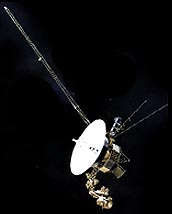 JPL Photojournal page
JPL Photojournal page
Wikipedia page
Voyager 2 Spacecraft in 3-D:
#1 #2
![]() #3 Location
#3 Location
Ring System: Yes (very faint)
NASA Hubble Image
![]()
NASA Diagram
Uranus Structure
Compared to Other Outer Planets
Planet Classifications:
Outer Planet (along with Jupiter, Saturn & Neptune)
Ice Giant (mostly hydrogen, helium & ices)
Superior Planet (has larger orbit than Earth)
Orbit:
(1.6.x)
(1.4.1)
NASA Graphic of Orbit
Period: 84.011 Earth years
Distance from Sun:
Mean (Earth = 1 AU): 19.201 AU
Mean: 2,872,460,000 km
Perihelion: 2,741,300,000 km (18.324 AU)
Aphelion: 3,003,620,000 km (20.078 AU)
Velocity:
Mean: 24,516 km/hr
Min: 23,364 km/hr
Max: 25,596 km/hr
Eccentricity: 0.0457
Inclination to Ecliptic: 0.772°
Number of Moons: at least 27 (more suspected)
5 Major Moons

Compare to Other Moons
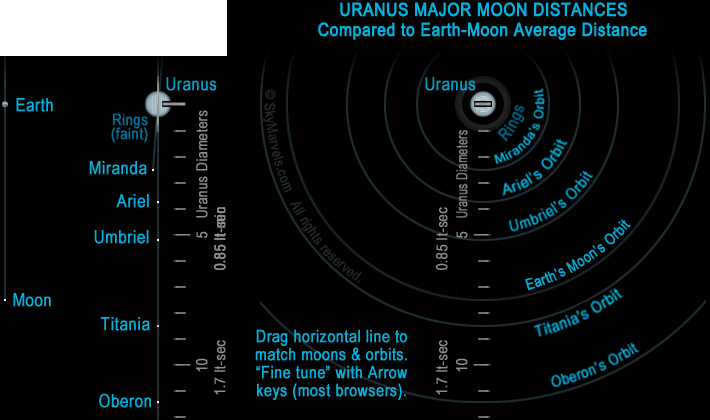
Current Major Moon Positions Viewed from Earth
Find Current Major Moon Pos. with NASA/JPL Orrery
Opens showing Uranus. Scroll out with mouse-
wheel to see major moons in orbit.
NASA's Uranus Moons Overview
Wikipedia's Moons of Uranus page
JPL Photojournal page for Uranus and its Moons
Miranda
Dimensions: 480 x 468.4 x 465.8 km
Rota. & Orb. Period: 1.413 d
Orbital Radius: 129,900 km
View In 3-D Another
![]()
Ariel
Dimensions: 1,162.2 x 1,155.8 x 1,155.4 km
Rota. & Orb. Period: 2.520 d
Orbital Radius: 190,900 km
View In 3-D Another
![]()
Umbriel
Mean Diameter: 1,169.4 km
Rota. & Orb. Period: 4.144 d
Orbital Radius: 266,000 km
View In 3-D Another
![]()
Titania
Mean Diameter: 1,577.8 km
Rota. & Orb. Period: 8.706 d
Orbital Radius: 436,300 km
View In 3-D
![]()
Oberon
Mean Diameter: 1,522.8 km
Rota. & Orb. Period: 13.463 d
Orbital Radius: 583,500 km
View In 3-D Another
![]()
Information Source: NASA Fact Sheets
URANUS'S SWARM OF MOONS
ADJECTIVES MEANING
"pertaining to Uranus"
Uranian, Ouranian
VOYAGE OF DISCOVERY
video credit: NASA JPL-CalTech
NASA's Voyager Mission Overview
Home Intro News Gallery Sky-Gifts Bonuses Tips
Learning Ctr Help Links Credits Legal Contact Us
© 2007-
by Gary M. Winter. All rights reserved.
Interested in political cartoons and humor?
Check out The HIPPLOMATS™.
SkyMarvels, Sky Marvels, SkyMarvels.com, URANUS Info., URANUS, Voyager, Voyager 1, Voyager 2, celestia4all, celestiaforall, CELESTIA, astronomy, space, simulations, animations, downloadable astronomy posters, stars, planets, Inner Planets, Outer Planets, Inferior Planets, Superior Planets, moons, asteroids, comets, Oort Cloud, galaxy, galaxies, Milky Way, Andromeda, globular clusters, binaries, quasars, black holes, supermassive black holes, telescope, telescopes, planetarium, software, freestuff, satellites, add-ons, addons, scripts, eclipses, Solar Eclipses, Lunar Eclipses, Solar Eclipse Finder, Lunar Eclipse Finder, mutual eclipses, transits, occultations, Solar System, CELES-TOOLS, celeSTARrium, CELX, CELX programming, Freebies, Bonuses, multiple views, atronomical unit, light year, parsec, meteors, meteor showers, Perseids, Geminids, Leonids, barycenter, time, Time Zones, tides, alignments, conjunctions, oppositions, seasons, apogees, perigees, aphelion, perihelion, Earth, Luna, Mercury, Venus, Mars, Jupiter, Galilean Moons, Io, Europa, Ganymede, Callisto, Saturn, Titan, rings, Uranus, Neptune, Triton, E-MSpectrum, electromagnetic spectrum, astronaut, equinoxes, solstices, precession, rotation, spin, inclination, tilt, Ecliptic, orbits, ellipse, parabola, hyperbola
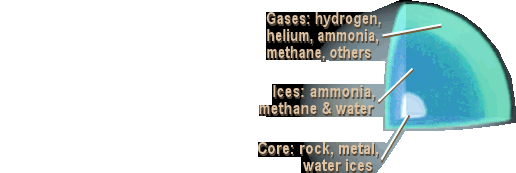
Donate safely with: PayPal
and receive one or more
Sky-Gifts. Your support is greatly appreciated!
NOTE: you do not need a PayPal account to donate.
SKY VIEWING
SOLAR SYSTEM
THE SUN
MERCURY
VENUS
EARTH
THE MOON
MARS
JUPITER
SATURN
URANUS
NEPTUNE
SMALLER WORLDS
STELLAR OBJECTS
EXOPLANETS
DEEP-SKY OBJECTS
SCALE OF THE COSMOS
———————
SKY-FUN / SKY-GAMES
URANUS FUN FACTS
Uranus is the furthest planet from Earth that can be seen with the naked eye!
Visible to the naked eye only under the most favorable conditions, Uranus was the first planet discovered using the telescope!
Scientists have determined that the clouds of Uranus smell quite like rotten eggs!
Uranus is the coldest major planet, even though it is closer to the Sun than is Neptune!
URANUS INTERACTIVES
QUICK ACCESS LIST
Note: some links are echoed elsewhere on this page and may include descriptive text.
Links to interactive features that show Uranus's orbit in 3-D can be found on our Solar System page
NASA's Voyager Mission Overview
Uranus Viewer lets you find the tilt of Uranus & its rings, and the location of its major moons, for any time and date.
Uranus Moon Tracker allows you to generate and download diagrams of the locations of Uranus's major moons and its Epsilon Ring over spans of time.
ELEMENTS OF URANUS'S MAJOR MOON ORBITS
| Period (Earth Days) |
Orbital Inclin- ation |
Radius (103 km) |
Eccen- tricity |
|
|---|---|---|---|---|
| Mir | 1.413 | 4.34° | 129.90 | 0.0013 |
| Ari | 2.520 | 0.04° | 190.90 | 0.0012 |
| Umb | 4.144 | 0.13° | 266.00 | 0.0039 |
| Tit | 8.706 | 0.08° | 436.30 | 0.0011 |
| Obe | 13.46 | 0.07° | 583.50 | 0.0014 |
The major moons of Uranus lack the strict resonances of the major moons of Jupiter and Saturn. This is partly
due to Uranus's lesser rotational flattening.
URANUS'S EQUINOXES
As each planet moves through the Solar System, twice during each orbit its equatorial plane aligns with the Sun. From a planet's own perspective, this is when the Sun moves across its celestial equator in its sky, and the planet's Northern and Southern Hemispheres are il-luminated equally.
Uranus's equinoxes occur ba- sically every forty-two years. At such times the planet's faint rings appear virtually invisible from Earth, because they are "edge on" to the Sun and lit very little by it. They are also nearly "edge on" to us here on Earth. Since most of Uranus's major moons orbit very near its equatorial plane, the condi- tions that are most conducive to producing their multiple and mutual eclipses always occur near the planet's equinoxes. Uranus's last equinox was on 2007 Dec 16, while it next will occur on 2050 Feb 9.
SKYMARVELS™
POSTERS FEATURING URANUS
SKYMARVELS™
VIDEOS FEATURING URANUS